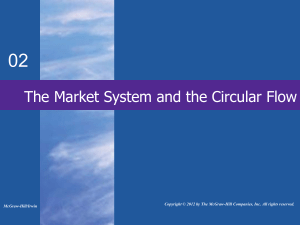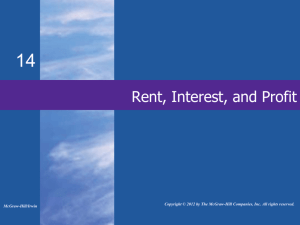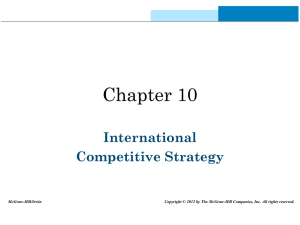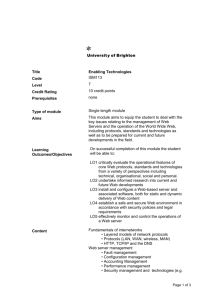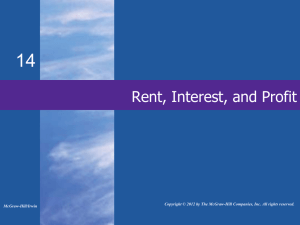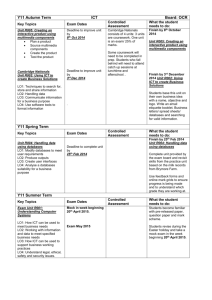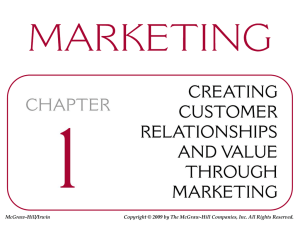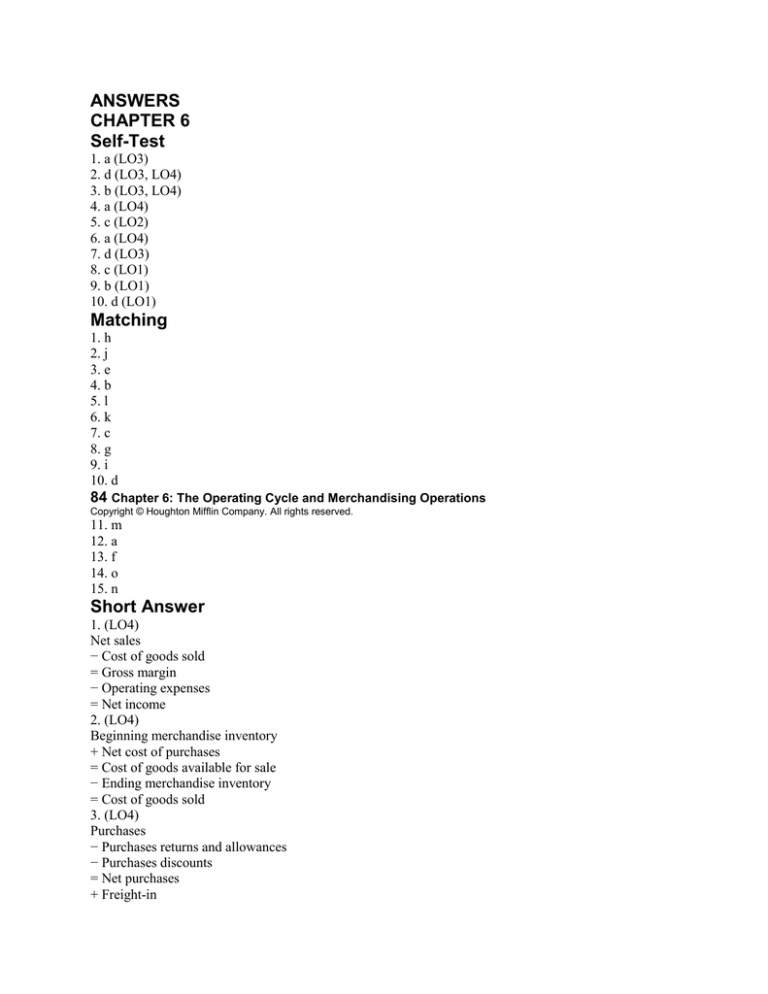
ANSWERS
CHAPTER 6
Self-Test
1. a (LO3)
2. d (LO3, LO4)
3. b (LO3, LO4)
4. a (LO4)
5. c (LO2)
6. a (LO4)
7. d (LO3)
8. c (LO1)
9. b (LO1)
10. d (LO1)
Matching
1. h
2. j
3. e
4. b
5. l
6. k
7. c
8. g
9. i
10. d
84 Chapter 6: The Operating Cycle and Merchandising Operations
Copyright © Houghton Mifflin Company. All rights reserved.
11. m
12. a
13. f
14. o
15. n
Short Answer
1. (LO4)
Net sales
− Cost of goods sold
= Gross margin
− Operating expenses
= Net income
2. (LO4)
Beginning merchandise inventory
+ Net cost of purchases
= Cost of goods available for sale
− Ending merchandise inventory
= Cost of goods sold
3. (LO4)
Purchases
− Purchases returns and allowances
− Purchases discounts
= Net purchases
+ Freight-in
= Net cost of purchases
True-False
1. F (LO4) Beginning inventory is needed.
2. F (LO2) It means that payment is due ten days after the end of the month.
3. T (LO1)
4. T (LO1)
5. T (LO2)
6. F (LO2) It is a contra account to sales.
7. T (LO4)
8. T (LO4)
Chapter 6: The Operating Cycle and Merchandising Operations
85
Copyright © Houghton Mifflin Company. All rights reserved.
9. T (LO1)
10. T (LO4)
11. F (LO3, LO4) It normally has a debit balance.
12. F (LO4) It requires a debit to Office Supplies (office supplies are not merchandise).
13. T (LO3)
14. F (LO2) They treat it as a selling expense.
15. F (LO4) Both are done at the end of the period.
16. F (LO2) A trade discount is a percentage off the list or catalogue price; 2/10, n/30 is a sales
discount, offered for early payment.
17. F (LO2) Title passes at the shipping point.
Multiple Choice
1. d (LO2) According to the terms, Bob would be entitled to a 2 percent purchases discount of
$10. In this example (after allowing for the purchase returns), the discount would be entered as a
credit to balance the journal entry, which would also include a debit to Accounts Payable for the
balance due ($500) and a credit to Cash for the balance due less the discount ($490).
2. c (LO4) Purchase Returns and Allowances is a contra account to the Purchases account.
Purchases has a normal debit balance. Its corresponding contra accounts have normal credit
balances.
3. b (LO4) Delivery Expense is a selling expense; it is not an element of cost of goods sold.
4. d (LO1) Exchange gains and losses arise when the exchange rate changes between the date a
purchase or sale has arisen and the ultimate acquisition of a foreign currency.
5. c (LO3) Under the perpetual inventory system, purchases of merchandise are recorded in the
Merchandise Inventory account, not in a Purchases account.
6. b (LO1) When operating expenses are paid for has no bearing on the length of the operating
cycle.
7. d (LO2) The entry would also include a debit to Credit Card Discount Expense for $50 and a
credit to Sales for $1,000.
8. a (LO1) The financing period equals the number of days taken to sell inventory, plus the
number of days to make collection, minus the number of days the company takes to pay its
suppliers for the goods (45 + 60 – 30 = 75).
Exercises
1. (LO4)
General Journal
Date Description Debit Credit
May 1 Purchases 500
Accounts Payable 500
Purchased merchandise on credit, terms n/30.
3 Accounts Receivable 500
86 Chapter 6: The Operating Cycle and Merchandising Operations
Copyright © Houghton Mifflin Company. All rights reserved.
Sales 500
Sold merchandise on credit, terms n/30.
4 Freight-In 42
Cash 42
Paid for freight charges
5 Office Supplies 100
Accounts Payable 100
Purchased office supplies on credit
6 Accounts Payable 20
Office Supplies 20
Returned office supplies from May 5 purchase
7 Accounts Payable 50
Purchases Returns and Allowances 50
Returned merchandise from May 1 purchase
9 Accounts Receivable 225
Sales 225
Sold merchandise on credit, terms n/30
10 Accounts Payable 450
Cash 450
Paid for purchase of May 1
14 Sales Returns and Allowances 25
Accounts Receivable 25
Accepted return of merchandise from customer of
May 9
22 Cash 200
Accounts Receivable 200
Received payment from customer of May 9
26 Cash 500
Accounts Receivable 500
Received payment from customer of May 3
2. (LO2, LO4)
Mammoth Merchandising Company
Partial Income Statement
For the Year Ended December 31, 20xx
Gross sales $100,000
Less sales discounts $ 300
Less sales returns and allowances 200 500
Chapter 6: The Operating Cycle and Merchandising Operations 87
Copyright © Houghton Mifflin Company. All rights reserved.
Net sales $ 99,500
Less cost of goods sold
Merchandise inventory, January 1 $10,000
Purchases $50,000
Less purchases discounts 500
Less purchases returns and allowances 500
Net purchases $49,000
Freight-in 2,000
Net cost of purchases 51,000
Cost of goods available for sale $61,000
Less merchandise inventory, December 31 8,000
Cost of goods sold 53,000
Gross margin $ 46,500

